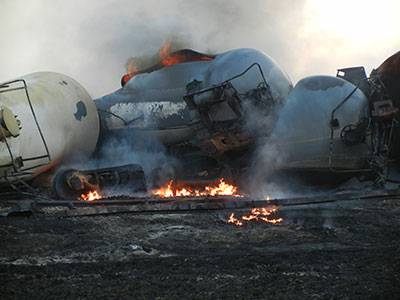The National Transportation Board (NTSB) Tuesday determined that a broken axle set off a series of actions that resulted in an accident in which about 476,000 gallons of crude oil spilled and ignited near Casselton, N.D., December 30, 2013, raising additional concerns about a widely used rail tank car.
The oil spilled from 18 of 20 derailed DOT-111 tank cars. The oil then formed pools that caught fire. Other derailed tank cars eventually ruptured as the heat from the fire weakened the tank steel and increased the internal pressure until oil vapor erupted in violent fireballs.
The NTSB has long had concerns about DOT-111 tank cars, which have a relatively thin 7/16-inch shell thickness, are not puncture-resistant and lack thermal protection as well as top and bottom fittings protection. Ensuring the safe shipment of hazardous materials is on the NTSB’s Most Wanted List of transportation improvements. The board Tuesday reiterated its recommendations for quickly phasing out DOT-111 rail tank cars and its variants.
Since the accident, Congress and the U.S. Department of Transportation have established requirements for a new, stronger DOT-117 tank car to replace the DOT-111. However, the deadline for replacing DOT-111 rail tank cars and its variants extends to 2029. Relatively few DOT-111s currently remain in crude-oil service, yet a vast fleet of these less-safe tank cars continues in service for ethanol and other flammable liquids.
“The fact remains that trains carrying flammable liquids in DOT-111 tank cars continue to roll through America’s towns and cities,” said NTSB Chairman Christopher A. Hart. “Progress toward removing or retrofitting DOT-111s has been too slow.”
The NTSB found that the chain of events for the accident began when a train carrying grain derailed because of a broken axle on one of its cars. NTSB investigators found a void in the middle of the axle, which was used previously on another train car. In response to the NTSB’s urgent safety recommendation on the matter, the American Association of Railroads has moved to require testing of secondhand use axles.
A second train on an adjacent track, carrying crude oil, was unable to stop in time before colliding with the derailed cars of the grain train.
There were no fatalities or serious injuries resulting from the accident, but nearly 1,500 people were evacuated from nearby homes. The accident could have been much worse had it not occurred about a mile outside of town.
As part of the accident investigation, the NTSB studied advanced brake systems. While their use would not have prevented the Casselton accident, it may have mitigated the damage. In other scenarios, advanced brake systems have the potential to prevent train accidents altogether.
Among its recommendations, the NTSB suggested studying the use of additional “buffer” cars between locomotives and cars carrying hazardous materials to protect crews. The Casselton oil train had a single buffer car between the locomotives and its hazardous cargo.





